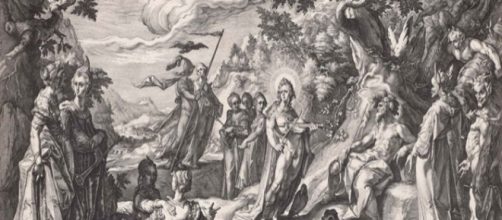A life lesson
He’s not exactly a household name, but German-born Henrick Goltzius, a late 16th century artist, whose engravings of Biblical, mythological, and allegorical subjects are currently on view at Switzerland’s Basel Kupferstichkabinetton, knew something that art makers and art lovers today don’t seem to know. The knowing begins with his work, which art historian of his time, Carel van Mander, described as so technically expert and inventive that Emperor Rudof II of Austria granted him a special privilege -- protection from imitators.Hold that thought.
Imitation is the segue to what Goltzius knew and to what today’s art world blinds itself.
Fooling the experts
Goltzius had a low opinion of art connoisseurs. As Van Mander tells it, the artist set out to demonstrate the fallibility of experts by playing a trick on them with an engraving he made in the style of Albrecht Durer, the early Renaissance superstar who lived a century earlier. Goltzius practically told the cognoscenti that the print was a fake by adding his own likeness to the picture, clearly indicating that the print couldn’t have been Durer’s since he died 89 years before Goltzius was born. Goltzius then burned and smoked the print with a hot coal so make it look old enough to be made by Durer.
Valuing a brand name
Disguised in this way, the fake Durer was shown around in Rome, Venice, Amsterdam and just as Goltzius expected, all the art world was ecstatic. The Durer brand sold and re-sold at high costs by buyers thrilled to have a work by such a famous artist. The Durer brand was held in such high regard that when questions arose about the possibility that Goltzius made the work given that his face was in the picture, the questioners were shouted down, by those who said that Goltzius couldn’t have made such an engraving even in a lifetime of trying.
And they went so far as to say that the imitation was the best print they’d ever seen by Durer.
Michelangelo also recognized the fallibility of experts and played a similar trick to prove it. The sculptor fashioned a sleeping Cupid, aged it in dirt so it had the look of an unearthed antiquity. It was so persuasive that he was able to sell it and for the going rate of an antiquity.
Game on
This same game continues to be played today, but openly, publicly, shamelessly. Artist Jeff Koons, for example, not only copies the work of others, but also sells it for record-breaking prices, even despite being sued four times for infringing on copyrights. Major museums are in on the game by mounting one-person shows of imitators’ stuff. The story that Michelangelo and Goltzius tried to tell is clearly lost on the art world today, and likely will stay lost. Likely that’s because people don’t care about authenticity anymore. Maybe they never did. As long ago as ancient Greece, Aesop observed that people often applauded imitations and hissed at the real thing.

